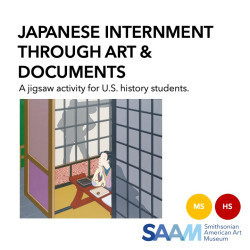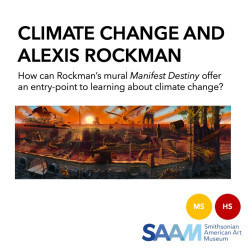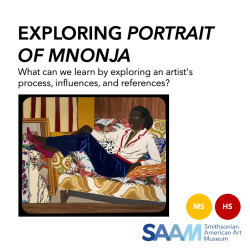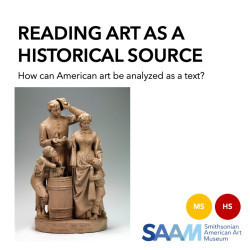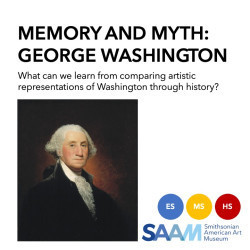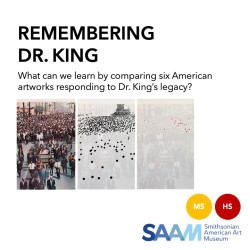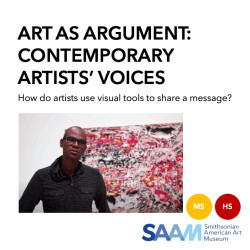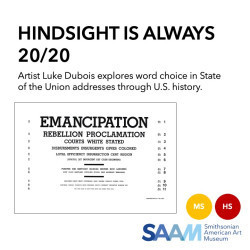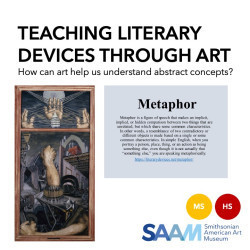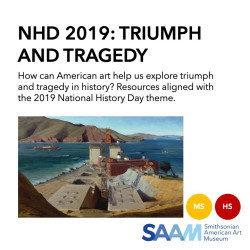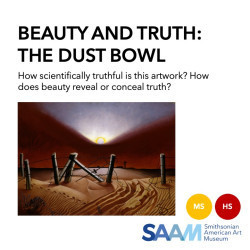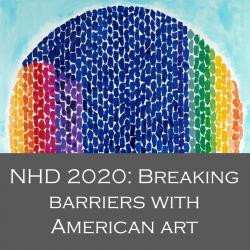Phoebe Hillemann
Teacher Institutes Educator
Smithsonian American Art Museum
As the Teacher Institutes Educator at the Smithsonian American Art Museum, I organize our week-long summer institutes for middle and high school English and social studies teachers: http://americanart.si.edu/institutes. I'm interested in interdisciplinary thinking, arts integration, and the power of dialogue in learning spaces.
Phoebe Hillemann's collections
The Subway
Artworks, photographs, and other documents relating to the New York subway system.
 Phoebe Hillemann
Phoebe Hillemann
8
Japanese American Incarceration through Art and Documents
<p>These resources can be used in an activity that introduces a lesson on Japanese American Incarceration during World War II. </p>
<p>1. To begin, show students Roger Shimomura's painting entitled Diary: December 12, 1941. Without providing any background information, use the "Claim, Support, Question" routine to have students make claims about what they think is going on in the artwork, identify visual support for their claims, and share the questions they have about the painting. Document responses in three columns on large chart paper or a whiteboard.</p>
<p>2. Following this initial conversation, share the title, artist's name, and date of the painting. Ask students to consider the date in the title, and discuss what significance this date might have. If they don't figure out that this date was five days after the Japanese bombing of Pearl Harbor, share that information. Share with students that this painting is part of a series Roger Shimomura created based on the wartime diary entries of his grandmother, Toku, who was born in Japan and immigrated to Seattle, Washington in 1912. Along with thousands of other people of Japanese ancestry living on the West Coast during World War II , Toku and her family were forcibly relocated to an incarceration camp after the attack on Pearl Harbor. Roger was a young boy during World War II, and remembers spending his third birthday in the Puyallup Assembly Center on the Washington state fairgrounds, where his family was sent before being transferred to Minidoka Reservation in Idaho for the duration of the war.</p>
<p>3. Jigsaw Activity, Pt. 1. After sharing this context, tell students they will each be receiving a primary source document that relates to the painting in some way. Distribute copies of "Woman at Writing Table," the Superman comic, the Instructions to All Persons of Japanese Ancestry, and Toku Shimomura's diary entries. Divide students into four groups, one per document. Give students time to analyze their document as a group and discuss how it affects their interpretation of the painting.</p>
<p>4. Jigsaw Activity, Pt. 2. Next, create new groups so that each group includes students who received each of the four sources. Ask students to briefly report on their document and what their original group discussed as its possible meaning and relation to Roger Shimomura's painting.</p>
<p>5. Return to the painting as a large group, and discuss how the primary source documents have influenced students' reading of the artwork. </p>
<p>6. Optional additional resource: If time allows, have students watch excerpts from Roger Shimomura's artist talk at the Smithsonian American Art Museum.</p>
<p>#APA2018</p>
<p><em>#visiblethinking</em><br></p>
 Phoebe Hillemann
Phoebe Hillemann
9
Climate Change and Alexis Rockman's Manifest Destiny
<p>In preparing to paint his large-scale mural, <em>Manifest Destiny</em>, a commission for the Brooklyn Museum's re-opening in 2004, Alexis Rockman consulted with climate change experts to imagine what Brooklyn might look like several centuries in the future when the glaciers have melted and sea levels have risen. </p><p>Teachers can use this painting as a starting point to discussing the issue of climate change, understanding what's at risk, and exploring mitigation strategies coastal cities might take to prevent an outcome like the one Rockman predicts.</p>
 Phoebe Hillemann
Phoebe Hillemann
6
Urbanized America: The American Experience in the Classroom
The early years of the twentieth-century saw a significant increase in economic inequality between the wealthiest Americans and the poorest. While the rich continued to bathe in their unregulated, post-industrial age economic success, the poor, largely represented by the overwhelming influx of new immigrants, remained trapped in an unrelenting cycle of poverty and adversity. Many struggled to find prosperity and acceptance in a country where some American citizens harbored foreign resentment and racism. Emblematic of the hardships they encountered is artist Everett Shinn’s chaotic scene of Lower East Side Jewish immigrants being evicted from their homes. This scene in downtown New York City is starkly contrasted with artist Childe Hassam’s romanticized view of an ethereal woman in her uptown home surrounded by beautiful objects likely acquired through European travel. She represents the prosperous post-industrial age, where wealthy patrons demonstrated their cultural sophistication through the acquisition and display of exotic, priceless objects in their homes.<br /><br />
The expanding urban population precipitated the introduction of new building materials in the development of high-rise buildings and tenements, revolutionizing urban living. Technological innovations like the electrified elevator and the Bessemer steel process replaced older building techniques and enabled the construction of high-rise buildings, the new symbols of American progress. However, overcrowding of the evolving urban landscape also gave rise to problems such as poverty, disease, and lawlessness. These issues ultimately led to crucial social reform and legislation, known collectively as Progressivism.<br /><br /><a href="http://americanexperience.si.edu/historical-eras/modern-united-states/pair-eviction-tanagra/">http://americanexperience.si.edu/historical-eras/modern-united-states/pair-eviction-tanagra/</a>
 Phoebe Hillemann
Phoebe Hillemann
21
Reading American Art as a Historical Source
<p>How can American art be read as a historical text? How can it be used to explore the 2018 National History Day theme of "Conflict and Compromise in History"? This collection examines two works of American art closely, modeling the process of historical inquiry and analysis. It also shares several online resources on reading artwork in a historical context, and suggests additional artworks from SAAM's collection that might support the theme of Conflict and Compromise.</p>
<p>#NHD2018 #NHD</p>
<p>Keywords: Reconstruction, Civil War, John Rogers, Winslow Homer<br></p>
<p><em>#historicalthinking</em></p>
<p><br></p>
 Phoebe Hillemann
Phoebe Hillemann
30
Memory and Myth: George Washington in American Art
<p>George Washington is one of the most mythologized icons of American history, and one of the most frequently represented figures in American art. What can comparing and contrasting these varying representations tell us about our national understanding of this founding father and first American President? How does the historical context during which an artwork was made affect its subject matter? How does American art influence the way we think of Washington today? </p><p>Created for the National Council for History Education (NCHE) 2018 annual conference.</p>
 Phoebe Hillemann
Phoebe Hillemann
19
Hindsight is Always 20/20
<p>In <em>Hindsight is Always 20/20</em>, Luke DuBois took the State of the Union addresses from each presidency (up through George W. Bush) and sorted them according to word frequency. The artist then printed the most frequently appearing works as an eye chart for each president, with the more frequently used words in larger type at the top of the chart and the less frequently used words toward the bottom. The traditional eye chart includes sixty-six letters; Luke DuBois’s charts substitute sixty-six words. The lists contain words that are not only important for the issues addressed by each president but also give an impression of how language was used at the time. Each of the forty-one presidencies to have State of the Union addresses at the time DuBois created this series (William Henry Harrison and James Garfield died before they could submit a single message to Congress) has its own eye chart. </p>
<p><em>Multiplicity</em>, 2011</p>
 Phoebe Hillemann
Phoebe Hillemann
42
Do Ho Suh: Almost Home
<p>Do Ho Suh’s immersive architectural installations—unexpectedly crafted with ethereal fabric—are spaces that are at once deeply familiar and profoundly alien. Suh is internationally renowned for his “fabric architecture” sculptures that explore the global nature of contemporary identity as well as memory, migration, and our ideas of home.</p>
<p>Suh was born in Korea and moved to the United States at the age of 29 in 1991, and he currently lives between New York, London, and Seoul. He crafts his works using traditional Korean sewing techniques combined with 3-D modeling and mapping technologies. Suh sees these works as “suitcase homes,” so lightweight and portable they can be installed almost anywhere.<br /></p>
<p>Essential Questions:</p>
<ul><li>What is home?
</li><li>How does perspective-taking help us better understand people, events, or issues?</li><li>How can artwork be used as a provocation for the exercise of higher order thinking and transdisciplinary application of content?</li></ul><p>Created for a program with the National Teachers of the Year on April 30, 2018.</p>
<p>#NTOY18</p><p><em>#visiblethinking</em><br /></p>
 Phoebe Hillemann
Phoebe Hillemann
13
Teaching Literary Devices through Art
<p>A good visual can often be the key to understanding (and remembering) a seemingly abstract concept. This collection demonstrates how artworks in the Smithsonian American Art Museum may be used to teach common literary devices in the English/language arts classroom such as metaphor, irony, symbolism, and more.</p>
<p>Key words: allegory, allusion, anthropomorphism, foreshadowing, irony, juxtaposition, metaphor, mood, motif, satire, suspense, symbol</p>
 Phoebe Hillemann
Phoebe Hillemann
30
#BecauseOfHerStory: Exploring Untold Stories through Portraiture and American Art
<p>Learn how American art and portraiture can bring diverse women’s stories into your classroom, connecting with themes you may already teach. Discover strategies for engaging your students in close looking and critical thinking across disciplines. #SAAMTeach #NPGteach<br /></p>
<p>RELATED WEBINAR SERIES (recordings available): <a href="https://americanart.si.edu/education/k-12/professional-development/webinars">https://americanart.si.edu/education/k-12/professional-development/webinars</a></p>
<p>This project received support from the Smithsonian American Women’s History Initiative. To learn more, visit the <a href="https://womenshistory.si.edu/">Smithsonian American Women History Initiative website</a>. #BecauseOfHerStory</p>
<p><br /></p>
 Phoebe Hillemann
Phoebe Hillemann
19
Beauty and Truth: The Dust Bowl
<p>This collection explores Alexandre Hogue's 1933 painting <em>Dust Bowl</em> through a global thinking routine called "Beauty and Truth." Supporting materials help build historical and scientific context. </p>
<p><em>“Some may feel that in these paintings . . . I may have chosen an unpleasant subject, but after all the [drought] is most unpleasant. To record its beautiful moments without its tragedy would be false indeed. At one and the same time the [drought] is beautiful in its effects and terrifying in its results. The former shows peace on the surface but the latter reveals tragedy underneath. Tragedy as I have used it is simply visual psychology, which is beautiful in a terrifying way.” -Alexandre Hogue</em></p>
<p><br /></p>
 Phoebe Hillemann
Phoebe Hillemann
12
Subway: Jigsaw Activity
<p>Resources compiled for the Smithsonian American Art Museum's <strong>Summer Institutes: Teaching the Humanities through Art </strong>for a session developed by Peg Koetsch.</p>
 Phoebe Hillemann
Phoebe Hillemann
13

